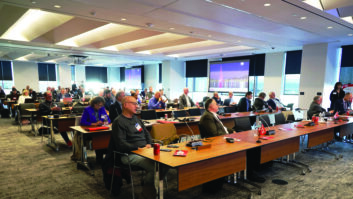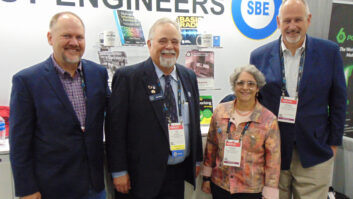
Ron Rackley
While the main focus of the Association of Federal Communications Consulting Engineers Oct. 30 technical symposium was on bettering the AM broadcast band, Ron Rackley, principal and senior engineer at du Treil, Lundin & Rackley, also provided a tutorial session covering the evolution of antennas used for transmission in the lower frequency portion of the spectrum. His history lesson spanned the antenna designed by Marconi for the first attempt at transatlantic communication attempt in 1901 to the folded monopoles of today.
Another history lesson of sorts was offered just outside the symposium presentation room by Tom King and Steve Smith from Kintronic Labs, who brought along a C-QUAM-equipped demo setup to illustrate how good analog AM audio can really sound and how AM stereo favorably compares with that transmitted via FM.
“What we’re trying to do is highlight the differences in quality if we use full 10 kHz-wide analog AM radio,” said King. “The idea is to show that the 15 kHz bandwidth of FM and the 10 kHz of wideband AM with stereo are closely comparable, and the standard bandwidth of [today ’s] AM — 2 kHz or so with no stereo — is awful by comparison. We’re trying to illustrate what AM can do with the right radios.”

Steve Smith (L) and Tom King show off their high-quality AM stereo demonstration set.
“This is the way that you save AM radio — by making it listenable,” added King. “When the listeners come back, the advertisers will come back and then the business will come back.”
When asked about the resurrection of C-QUAM AM stereo in connection with the demo, King explained that it was an effort to reduce the price tag associated with developing an improved AM broadcast system.
“All the C-QUAM patents that Motorola had have expired,” he said. “There are no royalties. This is now a public domain technology and we think that it will reduce the cost.”
Smith said that Kintronics is planning to show a new technology receiver incorporating C-QUAM and other software-defined features at the 2015 NAB Show.












